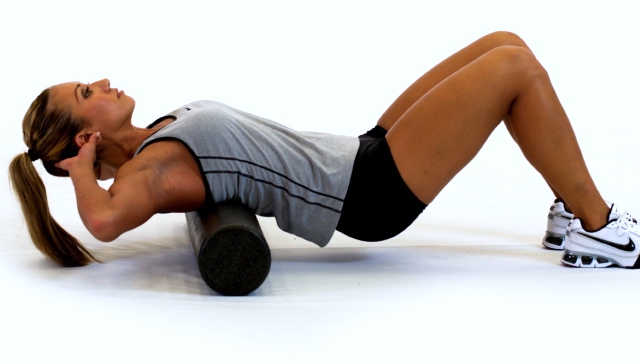If you’re active and participate in any of the fun sports this valley has to offer, you might benefit from daily foam roller stretching to alleviate soreness and promote recovery. Round foam rollers are either 1 or 3 feet long. Popular with savvy athletes, and used in sports medicine clinics for rehab, use of the rollers can help bring blood to tight muscles, help manage chronic problems, and can be used before or after activity. Rolling out your muscles can also warm up cold muscles before deeper stretching. Most gyms have them out for members to use. Similar to massage, in that pressure is applied to a knot, or trigger point, the technique is a form of self-massage called myofascial release. Your body weight resting against the foam roller acts like a steam iron on a wrinkled shirt, smoothing out these knots. As these knots warm up within the muscle and fascia, and unbundle into straighter alignment, you are able to access areas that are difficult to treat with conventional stretches. The technique is to simply stay on the tender spot for 20 to 30 seconds, until the pain starts to subside.
Muscles imbalances, misalignment, and overuse patterns usually create various aches and pains. Many can be addressed with self-myofascial release with the roller. Golgi tendon organs are proprioceptors , deep in tendons. The pressure of rolling on the roller relaxes muscles and other soft tissues so they begin to “let go”.
A Common Problem…. and RX
Sore knees are a common complaint among runners. An assessment of the lower leg, for example, might find that the individual excessively rolls their ankle and lower leg inward. A tight iliotibial band ( IT) may be the root of the problem. The iliotibial band attaches the gluteus maximus to the lower leg. In a normal gait, these muscles help control the leg as it moves over the foot. Since the IT band attaches to the lower leg, the excessive inward rotation of the leg can, over time, cause inflammation and pain in the IT band. In this scenario, here’s where the roller comes in:
Place the roller perpendicular to the outside of your thigh and lie over it. Roll over it at a rate of one inch per second, looking for any sore or tender spots. Hold your body weight there for 30- 40 seconds until the pain starts to subside. Try to relax, even if it is uncomfortable. Continue rolling down the side of your hip towards your knee. Roll each leg every day, for about 1-2 minutes. Make sure you don ’t roll over the knee joint.
Check out www.power-systems.com, www.gaiama.com or www.amazon.com to purchase one. Start off this fall stretched and ready to get outside and play!
Tag Archives: lower back pain
Are Kettlebells Good for your Back?
Back pain affects 60-85 percent of people worldwide, at one time or another, and half the population has their first lower back episode before age 20. It is the most common and expensive neuromuscular disorder. For most, the pain subsides in a few days, but for others, the right exercise program can restore and enhance back health. One of the biggest causative factors of lower back pain is the type and amount of mechanical loading placed upon the spine, such as bending, twisting and prolonged sitting. The good news is that you’ll have success if you incorporate exercises that develop power around the hips and gluteals. Many accomplished athletes and world-class strongmen with back pain credit a component of their success to kettlebells, a popular new trend in training. Yet others find that it irritates their backs. The kettlebell swing is a terrific dynamic total-body integration movement, but is it good for everyone? Kettlebells are bowling ball-size cast iron weights with a single looped handle on top. Unlike using regular weights, unique loading patterns are created throughout the body. The kettlebell swing is an example, in that the back, gluteal and external oblique muscles are turned on. To perform the swing, the kettlebell is held in your right hand. From a squat position with a neutral spine, the swing is initiated by simultaneously extending through your hips, knees and ankles, performed by swinging it to chest level and returning it. The move, says Stuart McGill, Ph.D., a professor of spine biomechanics and chair of the department of kinesiology at the University of Waterloo, is a “wonderful posterior chain balancer.” Pavel Tsatsouline, a former Soviet Special Forces trainer, started the kettelbell craze in the West in the 1990s. He and six other fit young men were part of Stuart Mcgill and Leigh Marshall’s research published in the Journal of Strength and Conditioning Research last month. McGill was curious about why the lower back loading of this exercise (the study included three others that I don’t have room for in this column) is therapeutic for so many accomplished athletes, yet troublesome for others. The swing itself needs sufficient spine stability to withstand the compression forces across the lumbar joints needed to accelerate the bell through the arc-like trajectory. The findings showed that compared to traditional squats or dead lifts, the ratio of compression to shear is quite different. Unstable spinal joints may experience micro-movements from these forces, causing discomfort. Most people with painful back conditions tend to use their backs more by moving the spine instead of the hips when it is under load. The spine may be better able to withstand high loads if it is postured close to its natural curves, and stiffened with abdominal wall contraction, McGill notes. He suggests using good form by bending at the hips in the squat part of the move (and any other type of squat), rather than spine motion. If it is appropriate for you, enjoy including kettle bells into your workouts. Connie Aronson is a fitness specialist based in Ketchum.

